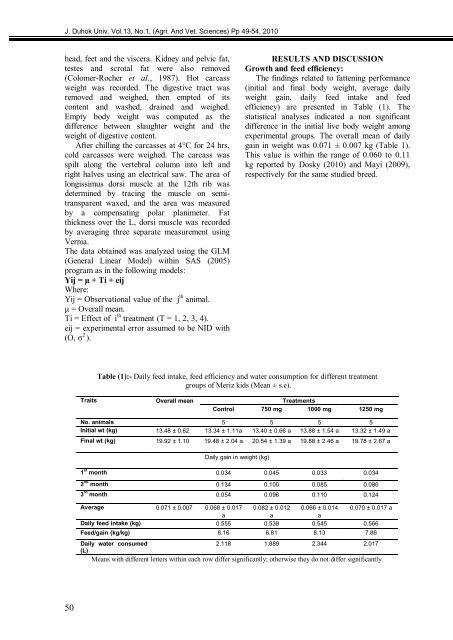The Influence Of Priming Two Cucumber Cultivar Seeds
The Influence Of Priming Two Cucumber Cultivar Seeds
The Influence Of Priming Two Cucumber Cultivar Seeds
Create successful ePaper yourself
Turn your PDF publications into a flip-book with our unique Google optimized e-Paper software.
J. Duhok Univ. Vol.13, No.1, (Agri. And Vet. Sciences) Pp 49-54, 2010<br />
head, feet and the viscera. Kidney and pelvic fat,<br />
testes and scrotal fat were also removed<br />
(Colomer-Rocher et al., 1987). Hot carcass<br />
weight was recorded. <strong>The</strong> digestive tract was<br />
removed and weighed, then empted of its<br />
content and washed, drained and weighed.<br />
Empty body weight was computed as the<br />
difference between slaughter weight and the<br />
weight of digestive content.<br />
After chilling the carcasses at 4°C for 24 hrs,<br />
cold carcasses were weighed. <strong>The</strong> carcass was<br />
spilt along the vertebral column into left and<br />
right halves using an electrical saw. <strong>The</strong> area of<br />
longissimus dorsi muscle at the 12th rib was<br />
determined by tracing the muscle on semitransparent<br />
waxed, and the area was measured<br />
by a compensating polar planimeter. Fat<br />
thickness over the L, dorsi muscle was recorded<br />
by averaging three separate measurement using<br />
Vernia.<br />
<strong>The</strong> data obtained was analyzed using the GLM<br />
(General Linear Model) within SAS (2005)<br />
program as in the following models:<br />
Yij = μ + Ti + eij<br />
Where:<br />
Yij = Observational value of the j th animal.<br />
μ = Overall mean.<br />
Ti = Effect of i th treatment (T = 1, 2, 3, 4).<br />
eij = experimental error assumed to be NID with<br />
(O, σ 2 ).<br />
05<br />
RESULTS AND DISCUSSION<br />
Growth and feed efficiency:<br />
<strong>The</strong> findings related to fattening performance<br />
(initial and final body weight, average daily<br />
weight gain, daily feed intake and feed<br />
efficiency) are presented in Table (1). <strong>The</strong><br />
statistical analyses indicated a non significant<br />
difference in the initial live body weight among<br />
experimental groups. <strong>The</strong> overall mean of daily<br />
gain in weight was 0.071 ± 0.007 kg (Table 1).<br />
This value is within the range of 0.060 to 0.11<br />
kg reported by Dosky (2010) and Mayi (2009),<br />
respectively for the same studied breed.<br />
Table (1):- Daily feed intake, feed efficiency and water consumption for different treatment<br />
groups of Meriz kids (Mean ± s.e).<br />
Traits Overall mean Treatments<br />
Control 750 mg 1000 mg 1250 mg<br />
No. animals 5 5 5 5<br />
Initial wt (kg) 13.48 ± 0.62 13.34 ± 1.11a 13.40 ± 0.66 a 13.88 ± 1.54 a 13.32 ± 1.49 a<br />
Final wt (kg) 19.92 ± 1.10 19.48 ± 2.04 a 20.54 ± 1.39 a 19.88 ± 2.46 a 19.78 ± 2.67 a<br />
Daily gain in weight (kg)<br />
1 st month 0.034 0.045 0.033 0.034<br />
2 nd month 0.134 0.100 0.085 0.086<br />
3 rd month 0.054 0.096 0.110 0.124<br />
Average 0.071 ± 0.007 0.068 ± 0.017 0.082 ± 0.012 0.066 ± 0.014 0.070 ± 0.017 a<br />
a<br />
a<br />
a<br />
Daily feed intake (kg) 0.555 0.538 0.545 0.566<br />
Feed/gain (kg/kg) 8.16 6.81 8.13 7.86<br />
Daily water consumed<br />
(L)<br />
2.118 1.889 2.344 2.017<br />
Means with different letters within each row differ significantly; otherwise they do not differ significantly.



